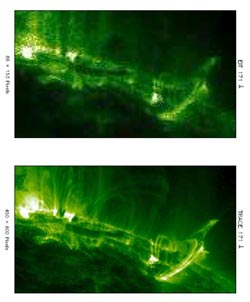Hi-C to Investigate Activity in Solar Atmosphere

Hi-C will image the Sun at a 5x higher resolution (0.1 arcsec/pixel image) than any previously done. The mission will demonstrate the technology necessary to collect 150-kilometer-resolution images of the sun in the extreme ultraviolet spectrum. Using a resolution 5 times greater than any previous imager, Hi-C will observe the small-scale processes that exist everywhere in hot magnetized coronal plasma. Above image is 0.5 arcsec/pixel. (NASA) <br>
Key partners include the University of Alabama at Huntsville, Smithsonian Astrophysical Observatory, University of Central Lancashire in Lancashire, England, and the Lebedev Physical Institute of the Russian Academy of Sciences.
Understanding the sun's activity and its effects on Earth's environment is the critical scientific objective of Hi-C, which will provide unique, unprecedented views of the dynamic activity in the solar atmosphere.
The telescope is slated for launch in July 2012. It will fly aboard a Black Brant sounding rocket to be launched from the White Sands Missile Range in New Mexico.
The mission will demonstrate the technology necessary to collect 150-kilometer-resolution images of the sun in the extreme ultraviolet spectrum. Using a resolution 5 times greater than any previous imager, Hi-C will observe the small-scale processes that exist everywhere in hot magnetized coronal plasma. Additionally, the mission is designed to study the mechanisms for growth, diffusion and reconnection of magnetic fields of the corona, and to help understand the coupling of small-scale dynamic and eruptive processes to large scale dynamics.
A major scientific impact of Hi-C will be to place significant new constraints on theories of coronal heating and structuring, by establishing whether or not there is additional fine structure below the current level of resolution.
“This instrument could push the limits on theories of coronal heating, answering questions such as why the temperature of the sun's corona is millions of degrees higher than that of the surface,” said Marshall heliophysicist, Dr. Jonathan Cirtain, who is Principle Investigator, on the Hi-C mission.
“Hinode has shown that current instrumentation used for coronal structure studies has insufficient resolution to separate individual features along the line-of-sight,” Cirtain said. “Hi-C will accomplish this measurement, with margin”.
For more information about NASA and agency programs, please visit: http://www.nasa.gov Janet Anderson
Marshall Space Flight Center, Huntsville, Ala.
256-544-0034
janet.l.anderson@nasa.gov
Media Contact
More Information:
http://www.nasa.govAll latest news from the category: Physics and Astronomy
This area deals with the fundamental laws and building blocks of nature and how they interact, the properties and the behavior of matter, and research into space and time and their structures.
innovations-report provides in-depth reports and articles on subjects such as astrophysics, laser technologies, nuclear, quantum, particle and solid-state physics, nanotechnologies, planetary research and findings (Mars, Venus) and developments related to the Hubble Telescope.
Newest articles

Webb captures top of iconic horsehead nebula in unprecedented detail
NASA’s James Webb Space Telescope has captured the sharpest infrared images to date of a zoomed-in portion of one of the most distinctive objects in our skies, the Horsehead Nebula….

Cost-effective, high-capacity, and cyclable lithium-ion battery cathodes
Charge-recharge cycling of lithium-superrich iron oxide, a cost-effective and high-capacity cathode for new-generation lithium-ion batteries, can be greatly improved by doping with readily available mineral elements. The energy capacity and…

Novel genetic plant regeneration approach
…without the application of phytohormones. Researchers develop a novel plant regeneration approach by modulating the expression of genes that control plant cell differentiation. For ages now, plants have been the…





















